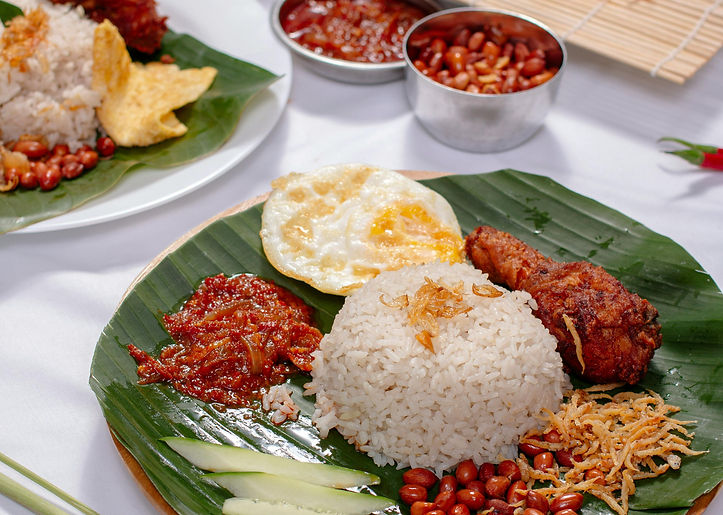Magazine

The Culinary Heart of Malaysia
Isabelle Monteiro
Wednesday, 28 May 2025
Exploring the rich tapestry of flavours that encompass Malaysia's culinary heritage.
The smell of coconut wafting through the air, the smoky taste of wok hei on your tongue—nothing makes a Malaysian salivate faster than their local food. The Southeast Asian country, whose landscape is a palimpsest of Malay, Chinese, and Indian historical and migratory influences, is a cornucopia of gastronomic treasures, a simmering pot of rich and flavourful decadence.
No other dish exemplifies this as well as Nasi Lemak, Malaysia’s national dish. It’s little wonder its name means “Fatty Rice”; the core of Nasi Lemak is a fragrant rice cooked in coconut milk and infused with pandan leaves, giving it a distinct aroma and flavour. Often accompanied by fried anchovies, peanuts, sliced cucumbers, a hard-boiled egg and fried chicken (Ayam Berempah), the star of the dish is sambal—a spicy chilli sauce made with dried chillies, shallots, garlic, and shrimp paste. Often eaten for breakfast, this meal is a union of heat and cool, soft and crunchy, sweet and savoury.
Then there is wok hei—the ineffable, smoky kiss that no home cook, no matter how skilled, can replicate exactly. It is the by-product of intense heat: a wok cradled in flames, and oil vapourising on contact with steel. It’s the invisible key element of Char Kuey Teow, the undisputed king of the hawker stalls. Flat rice noodles fried in garlic, spring onions, chilli and soy sauce, tumbling through the air with egg, bean sprouts, prawns, cockles and lap cheong, charred within the searing heat of the wok. It’s heaven and sin tossed into a singular dish. Most hawker stall vendors spend their lives perfecting one or two dishes, which is why you’ll find places like Penang’s Jin Kor Char Kuey Teow on prestigious food lists such as the Michelin Guide.

During Hari Raya Aidilfitri, families come together to celebrate the end of Ramadan, the season of fasting. Over tables laden with a delectable spread of kuih, glutinous rice and an assortment of curries, you’ll find matriarchs trading stories, bragging about the labour of each dish and how their recipes have been passed down through generations in their families. You see, Malaysian food isn’t just about the fire and intensity, it’s also about the slow, patient coaxing of flavour. Like beef rendang, whose cooking time of at least one-and-a-half hours reduces the coconut milk-based curry into a thick, glossy paste, infused with lemongrass, galangal and other spices.
The most astonishing thing, though, is how effortlessly the country’s food interacts. Aside from fusion cultures like Nyonya cuisine, which is an interpretation of Malay dishes influenced by Chinese, Indian, and Eurasian ingredients and cooking styles, Malaysia’s culinary heritage blends together naturally in everyday life. A typical morning begins with kaya toast—thick slices of toasted bread, slathered with coconut jam and butter, dipped into a soft-boiled egg laced with soy sauce. Lunch could be Nasi Kandar: a parade of Indian curries, ladled atop a mound of rice served on a banana leaf in chaotic yet delicious abandon. And then, as the day fades, you might find yourself at a night market, face flushed from the heat, fingers sticky with satay sauce, the night alive with a symphony of sizzling grills and the call of vendors hawking bowls of cendol—ice, palm sugar, coconut milk, red beans and pandan jelly, melding into a refreshingly sweet dessert.
So, while the heart of Malaysian cooking is its unapologetic indulgence in the aromatics and spices that breathe life and flavour into its diverse array of dishes, the soul of this cuisine is its understated ability to weave the nation’s passion and love for food into a savoury culinary experience.
Header image provided copyright free courtesy of Pexels. Article image credited to author Isabelle Monteiro.
For more content, follow us on Instagram, and like our Facebook page for more articles and information on how to join the Lingo Team.
Have an article ready to send in? Submit it here.
Barbara Dawson
Lovely tasty dish. Try it you won’t be disappointed.
Time Published
Aunty Liz
Very tasty and cheap. I often have this for tea!
Time Published
BETTS
Being a bilingual family (French mother and British father,) living in France I thought your article was extremely interesting . Have you research on bilingualism ? It seems that when the mother is British and the father French and they both live in France their children seem to be more bilingual than when the mother is French and the father is British . This is what we called mother tongue , isn't it ?
Time Published
Niamh
Such an interesting article!
Time Published





